AMD Next Horizon Gaming Live Coverage, Navi and Ryzen 3000
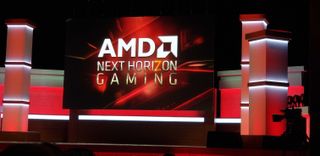
We're here for live coverage of AMD's Next Horizon Gaming event where we expect to learn more about the company's 7nm Ryzen 3000 processors and Navi GPUs.
AMD has already regaled us with its Ryzen 3000 processors that span from six cores and twelve threads up to 12 cores and 24 threads, all on mainstream motherboards. We expect to learn more from AMD about the X570 motherboard ecosystem, along with more specifics about the 7nm Navi GPUs.
Pricing, availability, and performance details should flow soon.
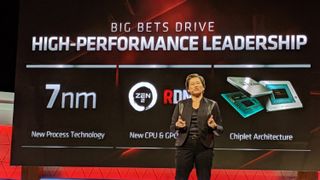
AMD CEO Lisa Su took the stage and began the show by talking about how much the company loves gamers and how the company is working to deliver incredible gaming experiences on all platforms with both breakthrough hardware and software. Su said that graphics are at the heart of gaming and that Radeon has permeated desktop PCs, consoles, and now mobile devices with the company's new partnership with Samsung.
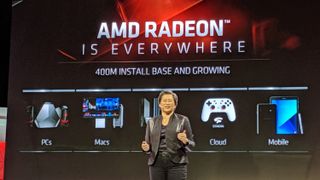
Su rehashed that the company is working with Sony to power its new console, and that Radeon will power Google's Stadia. Now the company is powering the Microsoft's Project Scarlett with a custom CPU and Navi GPU.

Su said the company is going to introduce the new Ryzen 3000 series processors, followed by the Navi graphics cards.
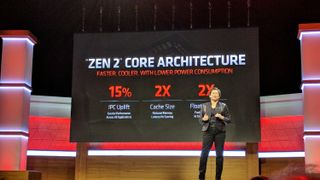
Su began by touting the enthusiast community's excitement for third-gen Ryzen. Su touted the 15% IPC uplift, doubled cache capacity, and doubled floating point performance.
Stay on the Cutting Edge
Join the experts who read Tom's Hardware for the inside track on enthusiast PC tech news — and have for over 25 years. We'll send breaking news and in-depth reviews of CPUs, GPUs, AI, maker hardware and more straight to your inbox.
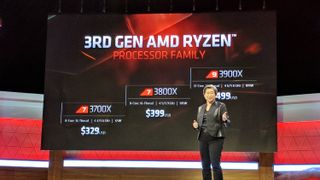
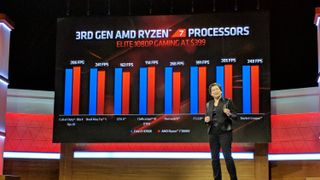
Su discussed the processors that the company announced during Computex 2019, discussing how the company is disrupting Intel at every price point.

Su demonstrated how the 12C/24T 3900X beats Intel's Core i9-9900K in single- and multi-threaded workloads, and at a lower TDP.
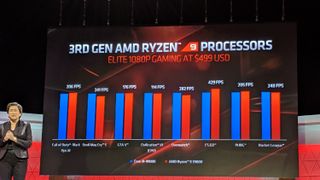
Su also showed how the Ryzen 9 3900X beats Intel at 1080p gaming across eight game titles.

AMD's Robert Hallock demonstrated the Ryzen 9 3900X streaming and playing a game simultaneously at 1440p compared to the Core i9-9900K. The Ryzen 9 3900X hit 59 FPS during the demo, while the Core i9-9900K hit 1.6 FPS, but it's notable that AMD used the "slow" preset, which is ultra-demanding, that wouldn't be used by nearly any streamer.
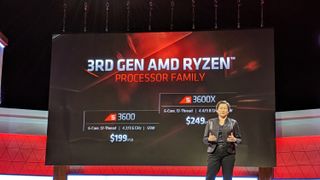
Su dove in deeper on the Ryzen 5 family. These 6C/12T processors deliver all the benefits of the Zen 2 core and PCIe 4.0 interface at friendlier price points.

AMD claims the processors outperform Intel's comparable models, like the Core i5-9600K.
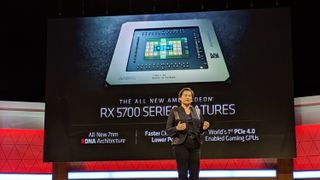
Su is now switching gears to AMD's Navi GPUs -- the 5700 Series. These new GPUs come infused with the new RDNA architecture that improves performance over the previous-gen GCN architecture. That comes due to faster clock speeds and improved IPC, paired with PCIe 4.0 and lower power consumption.
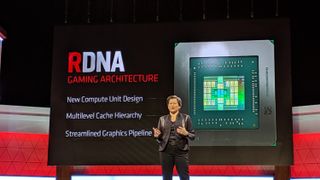
AMD retooled the cache hierarchy, streamlined the pipeline, and created a new compute unit (CU) architecture.
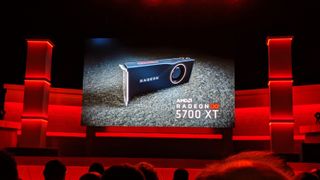
AMD claims a 25% increase in performance per cycle and 50% improvement in performance per watt with RDNA.
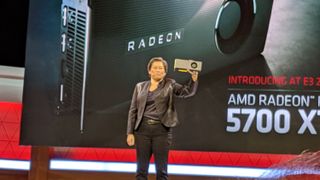
Su displayed the Navi 5700 XT graphics card.

These 7nm GPUs feature a range of improvements, along with a performance-driven design.
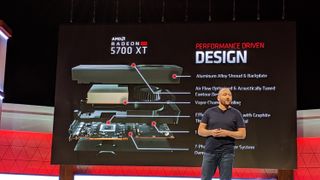
Navi includes a seven-phase power design fed by six-pin and eight-pin connectors.
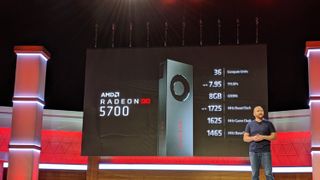
AMD introduced the Radeon 5700 with 36 compute units and 8GB of GDDR6. Look for our full breakdown of these cards to appear on the site at the end of the presentation.
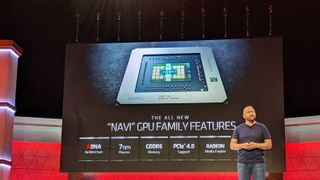
AMD introduced a new "Game" clock that represents what you would see during normal gaming. This new measurement slots between the base and boost clocks.

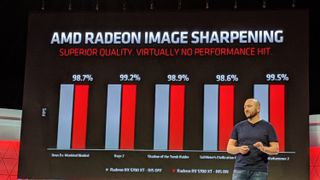
AMD introduced Fidelity FX, a new postprocessing effect that improves game quality. This sounds like an answer to Nvidia's DLSS. AMD made direct comparisons to DLSS, and then introduced Radeon Image sharpening, which is another post-processing technique to improve image quality.
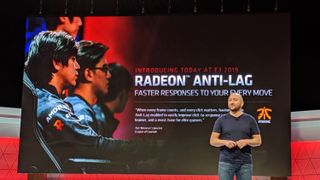
Herkleson introduced Radeon Anti-Lag, which reduces input lag, which Herkelson said will allow you to "beat GeForce gamers."

AMD presented before and after data in popular eSports game with the RX 5700 XT, saying you save 30% of latency on average.

Radeon RX 5700 XT will be available for $449. The Radeon RX 5700 will land at $379. Navi will be available on July 7, 2019, on the same release date as the Ryzen 3000 processors.
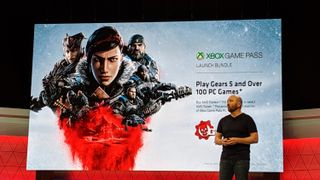
AMD is also including three months of the Xbox game pass with new Navi purchases.
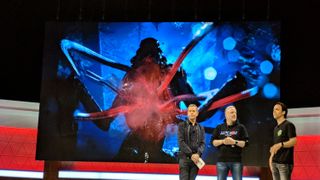
Geoff Keighley came out to help Herkleman introduce game developers that are working with AMD.
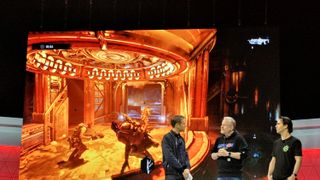
Keighley brought out The Coalition's studio head and technical director to talk about Gears 5. The developers talked about how they optimized Gears 5 for PCs by using PC-centric features.The developers infused the game with real-time cinematics at 4K resolutions. Because Xbox uses AMD graphics the developers spent more time working on game quality, as opposed to optimizing specifically for different types of GPUs.

The Executive Producer of Borderlands 3 came on the stage to talk about how the Gearbox team uses Ryzen and Radeon technologies to build games. The demo focused primarily on HDR effects and how the company used Fidelity FX to boost performance with rapid packed math. That technology helps improve image quality. Gearbox announced that it and AMD Studios have signed a multi-year agreement for its labs to use AMD hardware for game development. The company also showed exclusive gameplay footage from the upcoming title.

Keighley invited the Vice President of Graphics from Unity on to the stage to talk about Unity's latest news.

Tatarchuk outlined the company's new High-Definition Render Pipeline (HDRP) feature.

The company demoed gameplay footage from The Heretic, which uses HDRP. This new feature is optimized for the latest GPUs, but the company also worked closely with AMD to enable higher resolution, built on AMD's Fidelity FX. Unity also worked with AMD to integrate CAS into the game engine, which also uses rapid packed math. HDRP will ship this fall in Unity 2019.3.

Members of Ubisoft's Ghost Recon Breakpoint development team came to the stage to discuss their partnership with AMD. The company fine-tuned the game for Ryzen 3000 processors and the 5700 Series graphics cards.

Lisa Su returned to the stage and congratulated the Ghost Recon team. Su thanked Keighley for coming and he presented Su with a superhero model of herself made by the AMD fan community.
Su said she saved a surprise, or two, for the end.

Su just revealed a 50th Anniversary Edition of the Radeon 5700 XT. This model comes with gold highlights on the shroud, and it comes with faster performance, too. 40 Compute Units and a boost clock of 1.98 GHz. This card will be $499 and available exclusively at AMD.com.
Su said she has two kids - CPUs and GPUs. Because there was an extra GPU, there has to be an extra CPU.

Meet the Ryzen 9 3950X. 16 cores, 32 threads, and the 7nm Zen 2 microarchitecture. This new processor drops into AM4 motherboards and boost up to 4.7 GHz. It comes with 72MB of L3 all packed into a 105W TDP envelope. The CPU will come to retail in September for $749.
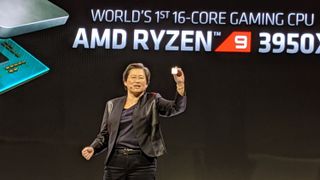

Paul Alcorn is the Managing Editor: News and Emerging Tech for Tom's Hardware US. He also writes news and reviews on CPUs, storage, and enterprise hardware.
-
-Fran- Well, I can say the 5700XT being $450 is lame with ~RTX2070 performance.Reply
That 8pin +6pin does not give me confidence of Navi being the mainstream offering but their failed attempt at high performance... I just hope I'm wrong and they have something more, but damn that price point makes little sense... Could it be the GDDR6????
Cheers! -
TJ Hooker Reply
What makes you say that? That's still $50 less than 2070 MSRP, and $30 than the cheapest 2070 on PCPP at the moment.Yuka said:Well, I can say the 5700XT being $450 is lame with ~RTX2070 performance. -
-Fran- Reply
You can find good aftermarket ones (already searched for them as soon as they announced the MSRP) and you can find them for ~470. And they come with a dual fan config instead of blower. I know this is more preference, but I'm really keen on not considering blower style coolers "good" anymore for reference designs.TJ Hooker said:What makes you say that? That's still $50 less than 2070 MSRP, and $30 than the cheapest 2070 on PCPP at the moment.
EDIT: I did have a good laugh with the streaming demo though.
Cheers! -
TJ Hooker Oh, yeah, I'm assuming the reference blower card will suck as they always do. Hopefully the AIB cards will be available for ~MSRP (or even less after they've been out a bit).Reply -
cryoburner Reply
There are rumors that Nvidia might be releasing some faster versions of their RTX cards, and possibly adjusting prices of existing models, which could make these prices even less attractive. I kind of have to agree that the pricing seems rather underwhelming, especially since we are comparing this against a card that came out 9 months prior. Nvidia's RTX pricing was widely considered to be poor, and this isn't much better. They are showing the 5700 as being around 10% faster than a 2060, but it also costs nearly 10% more. Yawn. It's even possible to find some of the single-fan 2060s on sale for as little as $320 right now, making the 5700's launch pricing closer to 20% higher than those models.TJ Hooker said:What makes you say that? That's still $50 less than 2070 MSRP, and $30 than the cheapest 2070 on PCPP at the moment.
Plus, the RTX cards have hardware to accelerate raytraced lighting effects, even if the performance might be questionable, and support limited. AMD hasn't shown off their own solution for realtime raytracing yet, leading one to suspect performance on their hardware will likely be worse, and probably closer to what we see with the GTX cards, which is to say more or less unusable. If that wasn't the case, I would have fully expected them to show off a preview of raytracing at their presentation, but they seem to not want to focus on that at all.
I guess the 5700 does have more VRAM than a 2060, which is one advantage that might help performance in some future games, but if those games feature raytracing, any of those gains will likely evaporate with that enabled.
Most Popular



